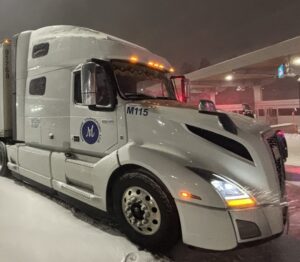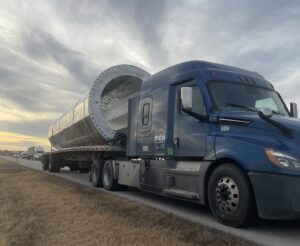WASHINGTON — The U.S. Department of Transportation’s Federal Motor Carrier Safety Administrator (FMCSA) Jan. 14 announced a new proposed pilot program for commercial motor vehicle (CMV) drivers to evaluate two additional options for splitting sleeper berth periods — a 6/4 split and a 5/5 split.
“FMCSA continues to explore ways to provide flexibility for drivers, while maintaining safety on our roadways. This proposed pilot program will provide needed data and feedback for the agency to use now and in the future. Gathering more data on split-sleeper flexibility will benefit all CMV stakeholders. We encourage everyone to review this proposal and provide their public comments,” said FMCSA Deputy Administrator Wiley Deck.
During the proposed pilot program, participating drivers would have the option to split their 10 hours of sleeper berth time into two periods — as long as each of the two periods is at least four hours and the combined time of the two periods equal at least 10 hours. Drivers participating in the program would also be free to choose whether or not to operate under the exemption based on their schedule. Carriers and drivers desiring to participate would apply to FMCSA for acceptance in the pilot program.
As part of its rulemaking process on hours-of-service (HOS) reform, FMCSA asked for public input regarding potential split periods of 6/4 or 5/5 in an effort to gather data on the two options. The agency did not receive any additional data during the comment period; this pilot program would help provide empirical data on potential split sleeper periods.
According to a statement from FMCSA, the agency has worked closely with motor carrier stakeholders on the issue of sleeper berth periods. Both motor carriers and organized labor have supported efforts to explore additional options. The International Brotherhood of Teamsters stated that “the majority of Teamster team drivers … indicated they preferred having more flexibility in the time that they can obtain restorative rest periods.”
Once published, the Federal Register notice will have a 60-day comment period. To read the Agency’s notice of the proposed pilot program, click here.
The Trucker News Staff produces engaging content for not only TheTrucker.com, but also The Trucker Newspaper, which has been serving the trucking industry for more than 30 years. With a focus on drivers, the Trucker News Staff aims to provide relevant, objective content pertaining to the trucking segment of the transportation industry. The Trucker News Staff is based in Little Rock, Arkansas.
















They just going to make the highways more dangerous than they already are because anymore there are just as many trucks that are on the road at night as during the day. They want to make highway safety get rid of the laws of letting 18/20 year olds crossing state lines. You should be no younger then 23 to even operate a CMV you run in to people of all ages out here with a CDL that doesn’t mean there a professional truck driver some of them only been driving 6 months to a year good lord you don’t hit professional status until you been out here on the road for 10 + year’s been driving 20+ years I learn something every single day and that is there are more assholes and idiots out hear then ever mostly being foreigners they go forward 70+ mph but can’t even back up they will park in the driveway of a travel plaza or truck stop cause they cannot back up thanks to the state of California for bringing them here and giving them a CDL JUST FOR A VOTE There are a lot more things they need to look at other then a split sleeper break I will not do it
I fell this should be shared before the comment session for this begins.
Drivers that made “adjustment’s” in their logs, to “get er done”, can no longer do that. These adjustments were often made because the HOS rules didn’t fit with the drivers NEED for sleep. If we look at the drivers daily priorities, before and after the ELD, we will see a subtle adjustment, which I believe is at the core of the crash increases. I wish I knew why the “sleeper study” was canceled. We could have gotten a lot of useful data that we could have used today. I would immediately restart this study on a very long term basis. Circadian rhythms of the OTR trucker needs to be studied over at least 3 months and at least 1000 drivers. For a quick fix, I suggest immediately implementing a 96 hour rule. When an OTR driver is fresh off a reset, his circadian rhythm will be askew. Well rested and ready to “get er done”, this driver may need a nap 4 hours into his day. Before the ELD, this driver would stop, take his nap, leave his log open and hope for the best. Later, he would add that nap to his next nap,meal,fuel, and shower. This is just one of many scenarios a sleeper study could look at. When I was OTR, this was a common scenario for me(minus the adjustments). Sometimes(often), scheduling would dump me right into the gridlock of rush hour. Your sleeper study would show the best case scenario of what happens when a driver naps, rather than driving into gridlock. I believe the sleeper study was canceled because there is to many scenarios to hold water.
This is where the 96 hour rule comes in. In most cases, and the way it’s supposed to work, a driver should be fresh, and ready to “get er done” after completing a reset. This “freshness” obviously deteriorates over time at different speeds, for different reasons. As this “freshness” deteriorates the risk for incidents increases. This is the “time” that needs to be studied with 1000 drivers over a long period of time. Now back to the quick fix. 96 hours is 4 days. A driver can make a lot of money in 4 days if he is allowed the flexibility to nap when he see’s fit. After 96 hours, normal or special rules can be implemented. I see the current HOS are allowing flexibility, but in my opinion, allowing this flexibility over an 8 day period will only increase crashes. It was my experience that after using split sleeper for 4 days, I started to become a shadow of myself using caffeine,sugar,nicotine, and bad carbs, to “get er done”. Because of the levels of these substances in my system, napping did nothing to gain back any “freshness”. There is no logical answer to why a trucker is basically required to use caffeine,sugar,nicotine, and bad carbs, to “get er done”. The 96 hour rule can give a driver an opportunity to get away from substances to stay awake, and simply take a nap, to gain real freshness.
Another key factor of the 96 hour rule would be this; I’ve read about it, spoke with many drivers about it, and lived it for 12 years. When driver goes home, his sleep can be only described as a disaster. (I strongly urge you to survey this fact). The 96 hour rule allow a driver to get real, stress free, REM sleep, soon after leaving home.
I would enjoy other options for splitting the sleeper birth
Back when I started driving we could do a 5/5 sleeper with no problem. Your tired then stop. The number one problem I’ve seen over the years is the 14hr clock is probably the biggest cause of fatigue.
Another post said something about the new young pups. Schools are still cranking them out and the companies are doing the same. I was a trainer and those I would not recommend to solo out was vetoed and sure enough within the first week they had an accident. I quit training after that.
How bout get rid of all those sleeper berth split….? Uh …? It not too complicated when it comes to do something about flexibility and safety for truck drivers. Hell it common sense……..!!!!! I stop when I feel tired and take as many naps as I need. See ?? Does it really need to be studied ??? Lord have mercy. Get rid of 14 hours rule …! Everyone out there with common sense would know it’s good just for stressing truckers lifestyle. Way too much regulations and way too much studies. All about politics and all about money. Nothing is about real flexibility and safety…!
Giving the flexibility of 6/4 and 5/5 would allow drivers to schedule better driving during rush hour.
I’ve been drying for 35 years and never had an issue with 5/5 years ago.
The issue is the 30 minute break and the 14 clock . This has drivers racing the clock and is allowing dispatch to tell drivers to run when they are tired.
To many times as of late we see driver running 30 mph across a truckstop parking lot to find a spot.
This ELD was never about safety, it is about pushing drivers